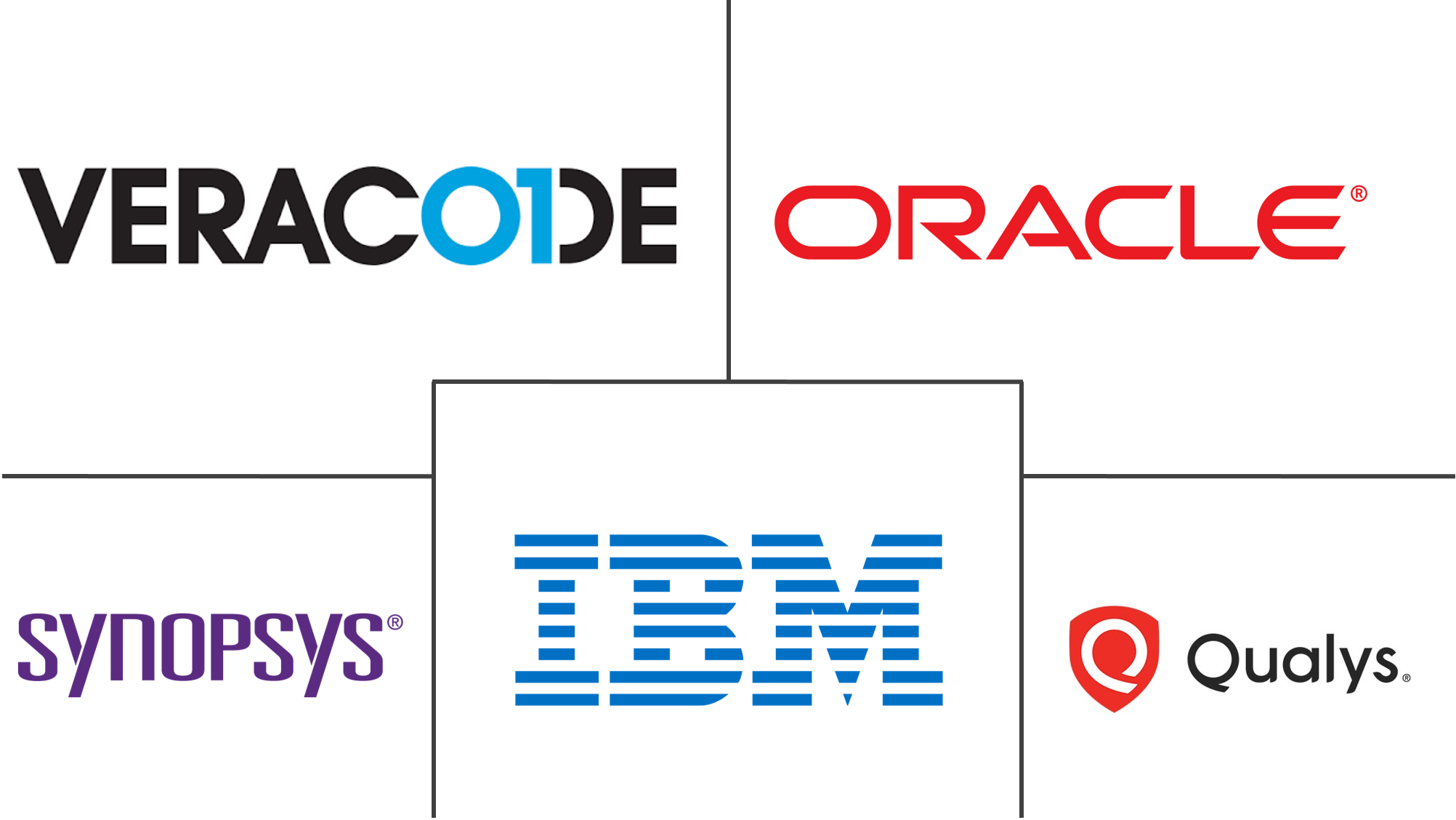Application Security Market Size and Share
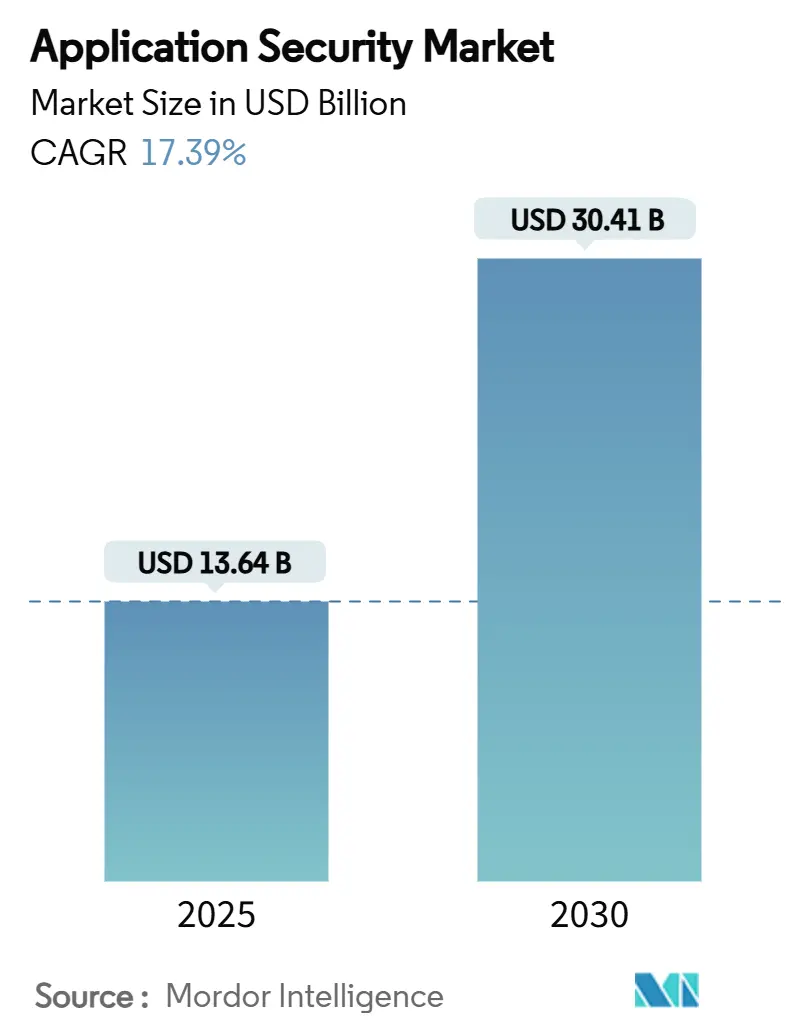
Application Security Market Analysis by Mordor Intelligence
The application security market was valued at USD 13.64 billion in 2025 and is expected to reach USD 30.41 billion by 2030, advancing at a 17.39% CAGR. Cloud migration, API-centric software design and expanding regulatory mandates are accelerating adoption across every major industry vertical. Growth is reinforced by a sharp increase in API traffic, the widespread use of AI-generated code and heightened incident disclosure rules that force organizations to strengthen testing earlier in the development life cycle. Large enterprises continue to anchor overall spending, yet managed platforms aimed at small and medium enterprises (SMEs) are opening a sizeable new addressable base for vendors. Technology convergence is reshaping competitive dynamics, with platform providers integrating static, dynamic and runtime protection to curb tool sprawl and improve developer productivity.
Key Report Takeaways
- By component, solutions accounted for 78.5% of the application security market share in 2024; services are projected to expand at a 17.9% CAGR to 2030.
- By deployment mode, cloud deployment commanded 65.9% of the application security market size in 2024 and is expected to post the fastest 19.3% CAGR over the forecast period.
- By organization size, large enterprises led with 63.4% revenue share in 2024, whereas SMEs are on track for an 18.2% CAGR through 2030.
- By security testing type, SAST captured 35.3% of the application security market share in 2024; IAST is set to rise at an 18.5% CAGR to 2030.
- By end-user industry, IT and telecom contributed 32.4% of 2024 revenue, while healthcare shows the highest 18.8% CAGR outlook.
- By geography, North America contributed 28.9% of 2024 revenue and Asia-Pacific is anticipated to register a 17.5% CAGR through 2030.
Global Application Security Market Trends and Insights
Drivers Impact Analysis
| Driver | (~) % Impact on CAGR Forecast | Geographic Relevance | Impact Timeline |
|---|---|---|---|
| Rising volume and sophistication of web-, mobile- and API-based attacks | +4.2% | Global, with highest impact in Asia-Pacific and North America | Short term (≤ 2 years) |
| Rapid adoption of DevSecOps toolchains | +3.8% | North America Asia-Pacific EU leading, expanding to Asia-Pacific | Medium term (2-4 years) |
| Expanding regulatory mandates (PCI-DSS 4.0, GDPR, DORA, etc.) | +3.5% | EU and North America primary, cascading globally | Medium term (2-4 years) |
| Growth in third-party/SaaS integrations | +2.9% | Global, concentrated in cloud-mature markets | Long term (≥ 4 years) |
| Mandatory SBOM disclosure post-US Executive Order 14028 | +2.1% | North America leading, EU following | Long term (≥ 4 years) |
| AI-generated code inflating unknown vulnerabilities | +1.4% | Global, concentrated in AI-adoption centers | Short term (≤ 2 years) |
| Source: Mordor Intelligence | |||
Rising Volume and Sophistication of Web, Mobile and API-Based Attacks
Web application attacks in the Asia-Pacific region surged 73% to 51 billion events in 2024, underscoring how attackers now exploit APIs at scale.[1]Adam Fisher, “State of the Internet / Security,” Akamai, akamai.com Retailers developing more than 1,000 APIs yearly confront an enlarged attack surface that bypasses perimeter controls. Supply-chain breaches climbed 431% between 2021 and 2023, demonstrating a pivot toward dependency exploitation rather than direct code injection. Enterprises are integrating runtime application self-protection with behavioral analytics to act on anomalous traffic patterns rather than static signatures. Manufacturing recorded a 79% API incident rate, confirming that adversaries move faster than most operational technology security programs.
Rapid Adoption of DevSecOps Toolchains
DevSecOps penetration rose from 27% in 2020 to 36% in 2024 as teams embed testing earlier in continuous integration pipelines. Platforms processing billions of findings, such as ArmorCode, apply machine learning to correlate vulnerabilities and prioritize remediation at scale. Despite progress, 78% of enterprises report “shift-left fatigue,” aggravated by redundant tools that overwhelm developers with alerts. The most effective programs streamline security tasks inside integrated development environments, treating policies as version-controlled artifacts automatically enforced at commit. This model is extending through AI assistants that suggest fixes inside code editors, thereby reducing context-switch time between development and security portals.
Expanding Regulatory Mandates
The Digital Operational Resilience Act (DORA) requires financial entities to report serious ICT incidents within four hours starting January 2025.[2]European Insurance and Occupational Pensions Authority, “DORA Final Regulatory Standards,” eiopa.europa.eu PCI DSS 4.0 adds 64 controls, including management of every discovered vulnerability, not just high-risk ones. Parallel initiatives such as the Cyber Resilience Act will impose security-by-design obligations across all connected products by 2027. Organizations respond by adopting unified compliance frameworks that map overlapping requirements to a single control set, lowering audit overhead. Vendor oversight is intensifying as DORA places critical ICT providers under direct regulation, driving demand for transparent security reporting and contractual enforcement language.
Growth in Third-Party SaaS Integrations
Average enterprises now use more than 1,000 SaaS applications, pushing global SaaS spending to USD 300 billion in 2025. Misconfigurations, such as the Oracle NetSuite exposure that leaked e-commerce customer data, illustrate how cross-platform data flows complicate risk management. Security teams are introducing Software Bills of Materials for SaaS ecosystems that catalog access permissions, API endpoints and data flows. API-first SaaS architectures create efficiencies for developers but also hand adversaries a single programmable gate into multiple services. Vendor consolidation in identity and integration management is underway to give organizations end-to-end posture visibility.
Restraints Impact Analysis
| Restraint | (~) % Impact on CAGR Forecast | Geographic Relevance | Impact Timeline |
|---|---|---|---|
| High total cost of ownership and tool complexity | -2.8% | Global, most pronounced in SMB segments | Medium term (2-4 years) |
| Global shortage of secure-coding talent | -2.1% | Global, acute in North America and EU | Long term (≥ 4 years) |
| False-positive overload eroding developer trust | -1.9% | Global, concentrated in high-velocity development environments | Short term (≤ 2 years) |
| "Shift-left fatigue" and tool sprawl | -1.5% | North America and EU primarily | Medium term (2-4 years) |
| Source: Mordor Intelligence | |||
High Total Cost of Ownership and Tool Complexity
Software-as-a-service inflation reached 11.3% in 2024, with some vendors lifting prices by 25%.[3]Emily Turner, “2024 SaaS Inflation Index,” Vertice, vertice.comForty-two percent of SMEs still lack a structured incident response plan, revealing budget constraints that limit enterprise-grade controls. Organizations deploy overlapping scanners, agents and policy engines that demand scarce integration skills, leading 89% of firms to foresee additional staffing needs despite flat headcounts. Managed platforms such as Contrast One™ now bundle expert services with tooling to cut administrative overhead. Consumption-based pricing models are also emerging, enabling smaller businesses to align spending with actual test frequency.
Global Shortage of Secure-Coding Talent
Thirty-two percent of employers struggle to recruit application security engineers, and headcount expansion slowed to 12% in 2024. GenAI is filling part of the gap, with 96% of practitioners using AI assistants to generate code or remediate findings. However, AI output can mask latent flaws that automated scanners overlook, creating a paradox where productivity increases but residual risk rises. Vendors are embedding intelligent training modules that teach secure-by-design patterns during code review sessions, shortening the learning curve for junior developers. Collaborative security champion programs inside large enterprises further distribute expertise so that bottlenecks do not rest solely on central teams.
Segment Analysis
By Component: Solutions Dominate Through Platform Consolidation
Solutions retained a 78.5% share in 2024, reflecting enterprise preference for integrated suites. Market leaders combine SAST, DAST, IAST and RASP under one license to limit tool sprawl. Consolidated dashboards reduce context switching and speed decision-making, fixing a common pain point cited by development teams. The service segment, though smaller, outran the broader application security market with a 17.9% CAGR and will continue to benefit from skills gaps.
Demand for managed security accelerates within SMEs that cannot afford full-time specialists. Providers use predictable subscription pricing and outcome-based service-level agreements to attract cost-conscious buyers. For large enterprises, professional services focus on policy mapping, pipeline integration and red-team simulations that validate runtime defenses. Vendors also introduce consumption-tiered offerings, letting customers buy scanning credits rather than perpetual seats, bringing transparency to budgeting for vulnerability management.
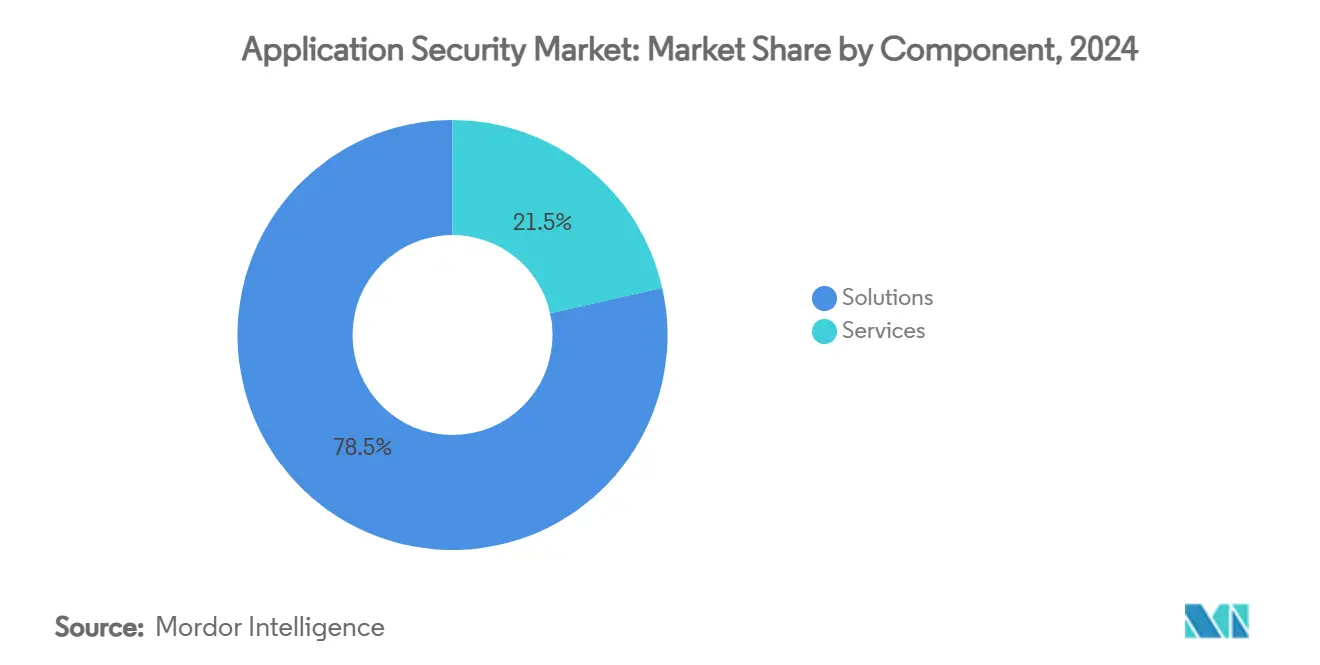
By Deployment Mode: Cloud Accelerates Through Regulatory Compliance
Cloud deployment controlled 65.9% of the application security market in 2024 and is forecast to advance at a 19.3% CAGR. DORA and related regulations specify four-hour incident reporting, a timeline difficult to meet without centralized logging and scalable analytics. Cloud-native solutions enable rapid rollout of policy updates and integrate easily with container orchestration systems.
On-premises solutions remain prevalent in defense and public-sector workloads that require data residency. Hybrid patterns are growing as financial firms keep sensitive workloads on private infrastructure while using cloud scanners during development. Cloud vendors invest in hardware-backed attestation and confidential computing to address lingering sovereignty concerns. Competition now centers on alignment with cloud security posture management functions that map misconfigurations across both infrastructure and application layers.
By Organization Size: SMEs Embrace Managed Services
Large enterprises represented 63.4% of 2024 spending due to multi-application portfolios and dedicated security budgets. Many manage in-house security operations centers that integrate testing data with enterprise SIEM platforms. They prioritize advanced use cases such as threat-informed defense simulation and self-healing code injection.
SMEs are the fastest-growing customer tier with an 18.2% CAGR, aided by simplified onboarding flows and pay-as-you-go pricing. Cloud-first scanners with built-in remediation guides give smaller teams near real-time feedback. Vendors also deliver curated policy templates aligned to common frameworks, sparing SMEs from drafting bespoke controls. Growing insurance incentives for verified security practices further fuel adoption among resource-constrained firms.
By Security Testing Type: IAST Gains Through Runtime Visibility
SAST held 35.3% revenue share in 2024 owing to deep IDE integration and wide language coverage. Even so, IAST posts the strongest trajectory because it captures runtime context and data flows across microservices. Development teams use its evidence-based findings to lower false positives, driving higher fix rates.
Dynamic testing remains relevant for production-like environments, especially when third-party components obfuscate code visibility. RASP is now common in industries with stringent uptime requirements since it blocks attacks without network rerouting. Software composition analysis gained momentum as supply-chain attacks multiplied, pushing executive orders that demand software bills of materials. Convergence of these methods under single orchestration engines is emerging, bringing unified reporting and automated risk scoring across the build-test-deploy pipeline.
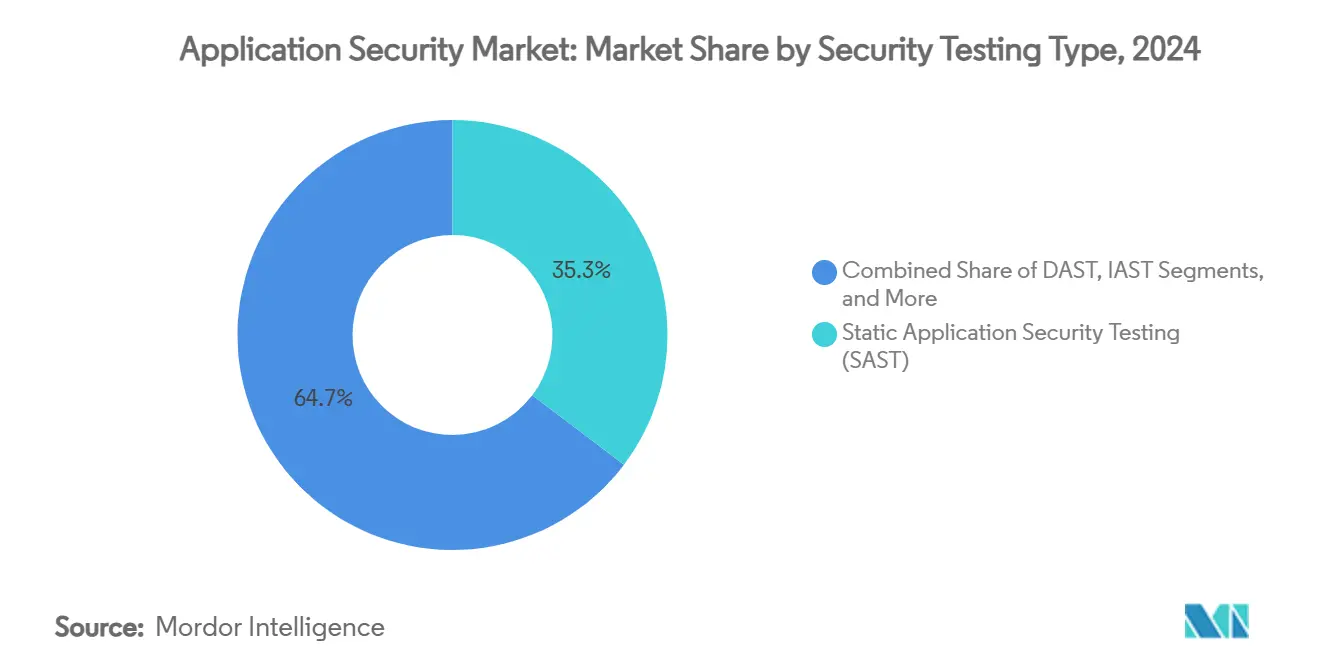
Note: Segment shares of all individual segments available upon report purchase
By End-User Industry: Healthcare Accelerates Through Regulatory Pressure
IT and telecom accounted for 32.4% of 2024 revenue on the back of mature digital infrastructure and formidable regulatory obligations. Continuous delivery demands force these firms to scan changes several times a day, creating volume-driven revenue for vendors.
Healthcare is expanding fastest at an 18.8% CAGR as HIPAA revisions tighten encryption and access-control mandates starting March 2025. Breaches such as Kaiser Permanente’s 2024 exposure of 13.4 million patient records heightened board-level attention. Solutions tuned for clinical workflows, audit logging and FHIR standards gain traction. BFSI continues to invest heavily to satisfy PCI DSS 4.0 and open banking rules. Retail and e-commerce emphasize API discovery and bot mitigation tied to omnichannel commerce expansion.
Geography Analysis
North America led the application security market with a 28.9% revenue share in 2024, underpinned by strong regulatory pressure and average Fortune 500 security budgets exceeding USD 20 million annually. Enterprises integrate zero-trust architectures that merge identity, network and application controls to support remote and hybrid work. Advancements originate in technology hubs where vendors pilot AI-driven vulnerability correlation workloads, delivering faster mean time to remediation.
Asia-Pacific records the fastest projected 17.5% CAGR through 2030, fueled by digital government programs, rising fintech adoption and a 73% spike in web application attacks that hit 51 billion events in 2024. Governments in Singapore and India release refreshed cyber strategies that map minimum control baselines for critical infrastructure. The region’s manufacturing sector, despite lower digital maturity, faces the highest share of API incidents, pushing vendors to localize threat intelligence and language-specific remediation resources.
Europe’s momentum hinges on comprehensive statutes such as DORA, the Cyber Resilience Act and GDPR. Financial entities must implement ICT risk management frameworks and deliver four-hour breach notifications from January 2025. Organizations allocate around 9% of IT budgets to information security, yet 89% still anticipate hiring increases to meet these mandates. Hybrid deployment preferences persist because data-sovereignty clauses encourage on-premise processing of sensitive workloads while permitting cloud-based analytics for less critical data.
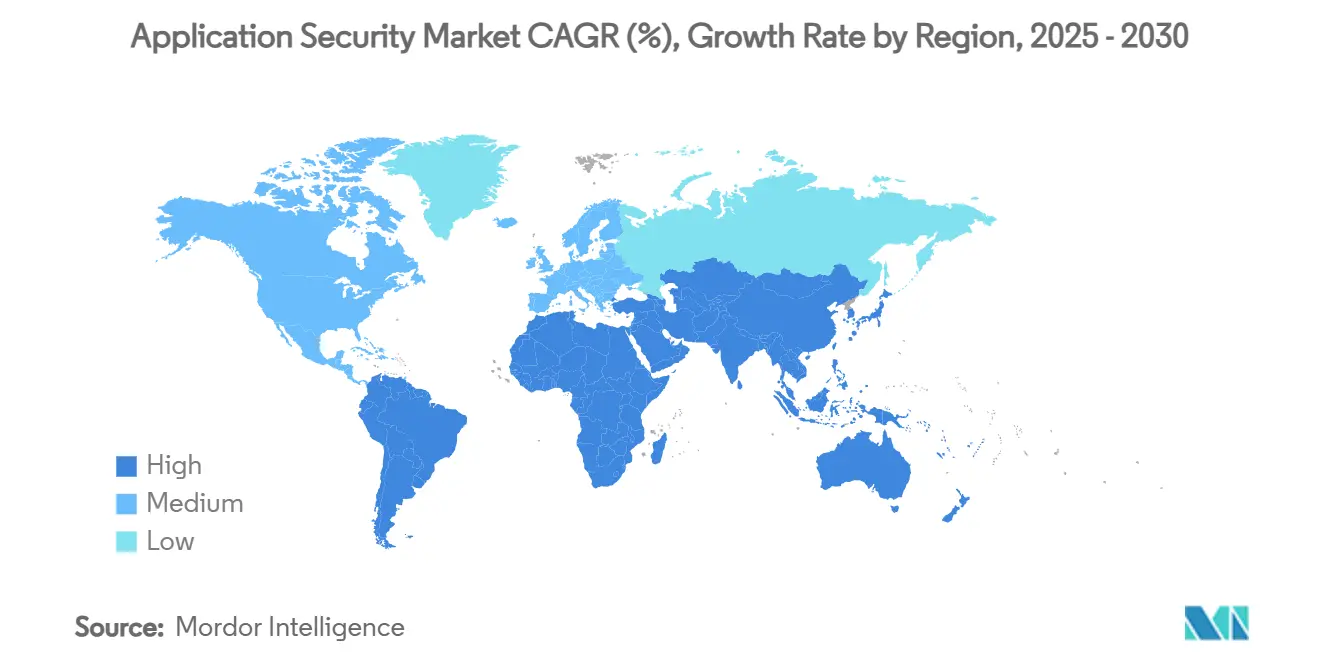
Competitive Landscape
The vendor arena is moderately fragmented yet consolidating as platform providers buy niche specialists to streamline customer toolchains. Akamai’s USD 450 million acquisition of Noname Security boosts its API protection depth and signals the strategic value of runtime traffic inspection. Snyk’s purchase of Probely broadens its dynamic testing footprint, letting developers address runtime flaws inside the same interface they use for code and dependency scanning. ArmorCode showcases AI-driven correlation that reduced triage time by 75% on ten-billion finding datasets, highlighting automation as a critical differentiator.
Emerging Application Security Posture Management (ASPM) platforms aim to centralize risk views across pipelines and production. Legit Security’s AI Discovery module identifies generative-AI created code, securing new attack surfaces before deployment. Patents filed by Amazon and IBM signal investments in adversarial detection and hybrid machine learning for anomaly spotting, respectively. Vendors now bundle interactive training in the product to shorten learning curves and raise fix rates. Price competition intensifies around usage-based billing that aligns testing costs with release velocity.
Application Security Industry Leaders
-
IBM Corporation
-
Oracle Corporation
-
Veracode (Thoma Bravo)
-
Synopsys Inc.
-
Qualys Inc.
- *Disclaimer: Major Players sorted in no particular order
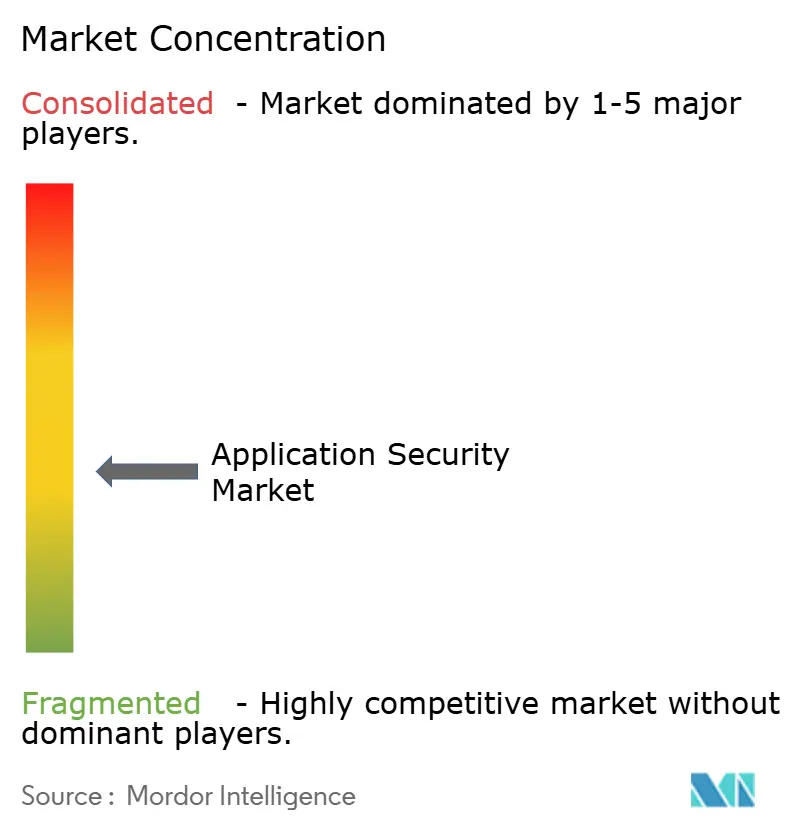
Recent Industry Developments
- July 2025: Contrast Security launched Contrast One™ managed application security service that pairs its runtime platform with expert staffing.
- July 2025: Contrast Security introduced Application Detection and Response technology for custom applications and APIs in production.
- June 2025: Akamai completed its USD 450 million acquisition of Noname Security to expand API protection.
- April 2025: Upwind acquired Nyx Security to integrate real-time code-level defense features.
Global Application Security Market Report Scope
Application security encompasses measures taken to improve the security of an application, often by finding, fixing, and preventing security vulnerabilities. Different techniques surface security vulnerabilities at various stages of an application's lifecycle, such as design, development, deployment, upgrade, and maintenance.
The Application Security Market is segmented by Application (Web, Mobile), Component (Services (Managed and Professions), Deployment (Cloud, On-Premise)), Organization Size (SMEs, Large Enterprises), Type of Security Testing (SAST, DAST, IAST, RASP), End-user Vertical (Healthcare, BFSI, Education, Retail, Government), and Geography (North America, Europe, Asia-Pacific, Latin America, and Middle East and Africa).
The market sizes and forecasts are provided in terms of value (USD billion) for all the above segments.
| Solutions |
| Services |
| Cloud |
| On-premise |
| Small and Medium Enterprises |
| Large Enterprises |
| Static Application Security Testing (SAST) |
| Dynamic Application Security Testing (DAST) |
| Interactive Application Security Testing (IAST) |
| Run-time Application Self-Protection (RASP) |
| Software Composition Analysis (SCA) |
| BFSI |
| Healthcare |
| Retail and E-commerce |
| Government and Defense |
| IT and Telecom |
| Education |
| Others |
| North America | United States | |
| Canada | ||
| Mexico | ||
| South America | Brazil | |
| Argentina | ||
| Rest of South America | ||
| Europe | Germany | |
| United Kingdom | ||
| France | ||
| Netherlands | ||
| Rest of Europe | ||
| Asia_Pacific | China | |
| Japan | ||
| India | ||
| South Korea | ||
| Rest of Asia-Pacific | ||
| Middle East and Africa | Middle East | United Arab Emirates |
| Saudi Arabia | ||
| Turkey | ||
| Rest of Middle East | ||
| Africa | Egypt | |
| South Africa | ||
| Nigeria | ||
| Rest of Africa | ||
| By Component | Solutions | ||
| Services | |||
| By Deployment Mode | Cloud | ||
| On-premise | |||
| By Organization Size | Small and Medium Enterprises | ||
| Large Enterprises | |||
| By Security Testing Type | Static Application Security Testing (SAST) | ||
| Dynamic Application Security Testing (DAST) | |||
| Interactive Application Security Testing (IAST) | |||
| Run-time Application Self-Protection (RASP) | |||
| Software Composition Analysis (SCA) | |||
| By End-user Industry | BFSI | ||
| Healthcare | |||
| Retail and E-commerce | |||
| Government and Defense | |||
| IT and Telecom | |||
| Education | |||
| Others | |||
| By Region | North America | United States | |
| Canada | |||
| Mexico | |||
| South America | Brazil | ||
| Argentina | |||
| Rest of South America | |||
| Europe | Germany | ||
| United Kingdom | |||
| France | |||
| Netherlands | |||
| Rest of Europe | |||
| Asia_Pacific | China | ||
| Japan | |||
| India | |||
| South Korea | |||
| Rest of Asia-Pacific | |||
| Middle East and Africa | Middle East | United Arab Emirates | |
| Saudi Arabia | |||
| Turkey | |||
| Rest of Middle East | |||
| Africa | Egypt | ||
| South Africa | |||
| Nigeria | |||
| Rest of Africa | |||
Key Questions Answered in the Report
What is the current size of the application security market?
The market is valued at USD 13.64 billion in 2025 and is projected to reach USD 30.41 billion by 2030.
Which deployment mode is growing fastest?
Cloud-based deployment is forecast to expand at a 19.3% CAGR, driven by scalability and new regulatory demands.
Why is API security attracting heightened investment?
API traffic growth and a 73% surge in web application attacks underline the need for specialized runtime visibility that traditional controls lack.
How are regulatory changes affecting application security budgets?
Acts like DORA and updated PCI DSS controls force continuous testing and four-hour breach reporting, prompting firms to allocate larger portions of IT budgets to application security.
Page last updated on:
